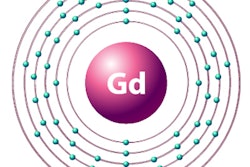
U.S. and international researchers with expertise in gadolinium retention and gadolinium-based contrast agents (GBCAs) plan to release a road map for exploring the reasons why increased signal intensity is being seen in patients years after they receive an MRI contrast agent.
The work-in-progress white paper is the result of a two-day workshop held in mid-February that was designed to identify knowledge gaps in research related to gadolinium retention. The paper will prioritize approaches to address the shortfalls and promote global collaborations; the goal is to submit the blueprint to Radiology in two months.
"There is no question about the fact that we see signals on our [MR] images that some form of gadolinium is left behind," said workshop co-chair Dr. Krishna Kandarpa, PhD, director of research sciences and strategic directions for the U.S. National Institute of Biomedical Imaging and Bioengineering (NIBIB). "Where people don't agree or don't know yet how to agree is whether this will cause symptoms. In as much as we are concerned by this, we would like to get ahead of it and come up with answers before it becomes a major concern."
Coordinated research
Approximately 100 researchers from around the world attended the event, which was sponsored by the U.S. National Institutes of Health (NIH), the American College of Radiology (ACR), and the RSNA. Dr. Herbert Kressel, editor emeritus of Radiology, co-chaired the meeting with Kandarpa.
 Dr. Krishna Kandarpa, PhD, from NIBIB.
Dr. Krishna Kandarpa, PhD, from NIBIB.The organizations were joined by representatives from the U.S. Food and Drug Administration (FDA), which plays a prominent role in how GBCAs are regulated.
Two months ago, the FDA issued a directive requiring GBCA manufacturers to add new warnings to their product labeling notifying healthcare providers that patients could retain gadolinium long after MRI scans take place. The agency mandated that contrast manufacturers conduct human and animal studies to further evaluate the safety of the contrast agents.
Interestingly, the FDA's guidance came seven months after the agency ruled there was no evidence that gadolinium retention in the body caused any adverse health effects.
"We wanted these experts, including the FDA, to come and talk about where the knowledge gaps are so we can come up with a road map to assess the issue surrounding these findings," Kandarpa said.
The FDA has drawn criticism for its stance from patient advocates, who believe the agency should take a more aggressive approach similar to that of the European Medicines Agency, which has required that several linear GBCA products be removed from the market.
Scientific strategy
The workshop participants are taking a scientific approach to the issue of gadolinium retention for research that may inform the potential risks to patients. For example, the researchers want to further explore what form of gadolinium is retained in the body.
"We suspect that it is not free gadolinium, but is it still bound to the original molecule?" Kandarpa posed. "Has it been exchanged to another molecule? Do [GBCAs] all behave the same way in the organs we look at -- the brain, the kidney, or bone? Those were some of the more fundamental issues."
Taking it one step further, the research road map is also expected to investigate ancillary ramifications. Do certain types of gadolinium affect certain symptoms in patients? And does it depend on retention in the body?
"What exactly is being left behind in the cells? How can we exactly establish the presence of this leftover gadolinium with any clinical symptoms?" Kandarpa added. "Maybe it is harmless in one place and harmful in another place. These are all unknowns."
Risk vs. benefit
Of course, by adding to the current knowledge on gadolinium retention, physicians can make better decisions regarding their patients. Kandarpa said that patients and doctors should talk to each other and weigh the alternatives if there is some concern or question about administering a GBCA.
"Patients still have their doctors, and they will still use these [gadolinium-based] contrast agents based on their risk-benefit analysis," he said. "If there is little or no risk to using it, then they will use it. If the benefit outweighs the risk of retaining a small bit of gadolinium, they may still use it."



.fFmgij6Hin.png?auto=compress%2Cformat&fit=crop&h=100&q=70&w=100)




.fFmgij6Hin.png?auto=compress%2Cformat&fit=crop&h=167&q=70&w=250)











